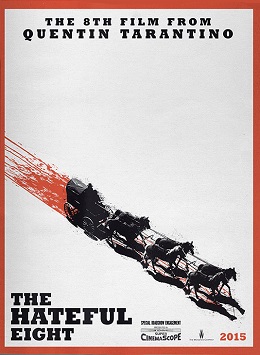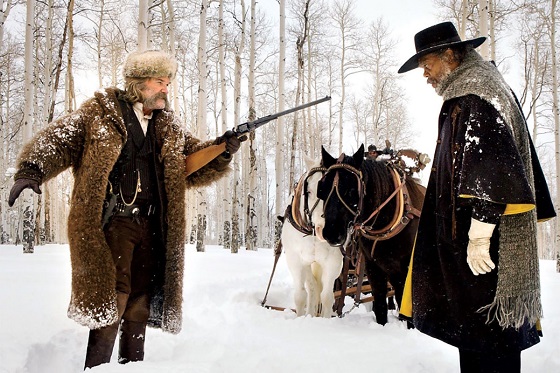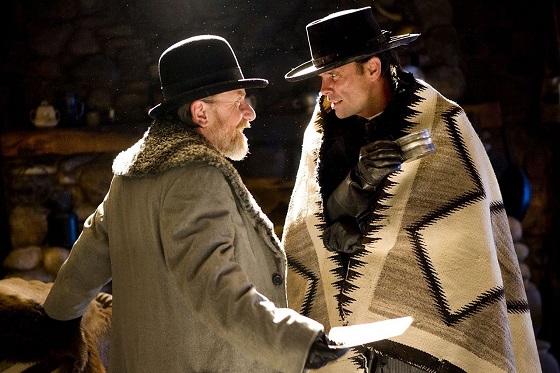Quentin Tarantino has always had a knack for dressing up the dregs of society and giving them their cinematic due. Killers, crooks, junkies, cowards: all have had their moments in the sun in Tarantino’s balmy universe. By grounding their stories in everyday conversations about tipping, cheeseburgers, Superman, film, and music, the colorful director allows his audiences access to these characters and their world, yet he never lets us forget whom we’re dealing with. At one moment, two hitmen might be having a rational conversation about divine intervention and fate, only to be interrupted the next minute by a rogue bullet that splatters someone’s brains all over them mid-sentence. In this way, Tarantino never lets us off the hook, for just when we allow ourselves the pleasure of mixing with these dark rogues, we’re shocked back into the pseudo-reality of the moment. These are bad people doing bad things, and although we might identify with them in passing, unfortunate things will inevitably happen to them or those nearby.
This dynamic is in full-effect in The Hateful Eight, Tarantino’s ode to “The West” and Hollywood’s mid-twentieth century cowboy culture obsession. The film opens with a stagecoach trudging along the frozen terrain of northern Wyoming, where deep snow and an approaching blizzard threaten any and all travelers in the vicinity. When bounty hunter Major Marquis Warren (Samuel L. Jackson) implores the stagecoach driver to give him a lift to Red Rock, the nearest town, Warren is told that he’ll have to run the request by the passenger who chartered the ride. That passenger, John Ruth (Kurt Russell), explains that he is transporting a dangerous criminal, and isn’t keen on taking any chances with company. Maj. Warren talks his way onto the stage, however, as does another man, Chris Mannix (Walton Goggins), a little further down the trail. All three travel with the driver and Ruth’s charge, Daisy Domergue (Jennifer Jason Leigh), until the blizzard forces them to stop at a trading post outside of Red Rock, where a colorful cast of characters awaits them.
Not exactly the trusting sort to begin with, Ruth begins to suspect that one (or more) of the people he’s trapped with in the trading post is not who they claim to be. What’s more, Ruth is convinced that the hidden villain is actually lying low and waiting for the opportunity to kill him and set Daisy free. It’s a slow burn, however, as Tarantino paces himself, and creates lines of division amongst this motley batch of rogues so as to stoke the fire under his suspense kettle. Social and racial tensions from a Civil War only recently concluded fracture the group along north-south lines, aided in no small part by the murderous suspicion that permeates the group as a result of Ruth and Daisy’s presence there. And while Tarantino takes his time moving his film’s pieces into place via flashbacks, monologues, and brash posturing, it is time very well spent. Like Ruth, the audience is watching every character closely for any perceptible crack in their façade, and over time, they do indeed begin to appear.
And while the far bloodier second half moves at a faster pace, it is the first half that makes The Hateful Eight the complete, strong picture that it is. There isn’t a split, fractured narrative like in Inglourious Basterds, or a meandering plot groping around for a resolution like in Django Unchained, but instead a focused movie with carefully planned beats which build upon the tension judiciously manufactured through each passing frame. This is Tarantino at his finest, for in The Hateful Eight the director has managed to perfectly balance homage with practicality, to properly weigh out the proportions between gleeful abandon (2nd half) and measured narrative focus (1st half). In other words, this is a movie where Tarantino is clearly having fun…like on a Kill Bill level, yet he never lets that get in the way of his movie’s core foundation as a mystery/suspense thriller.
As a result, aside from the fact that the film is nothing less than a balls-to-the-wall, blood-soaked, profane, good goddamned time, it also happens to be a well-proportioned, superbly executed suspense-thriller. Tarantino’s trademark juxtaposition of violence and comedy are on full display here, and play out with sharpness rivaled by nothing in the director’s catalogue, save, perhaps, Pulp Fiction. The dialogue is copious, and unspools like a ball of yarn dropped down a flight of stairs, yet it never proceeds for its own sake, and serves to advance the story and/or the audience’s understanding of the characters.
Special mention should go to Goggins, whose character arc and performance are a delight to behold. Along with Jackson and Russell, Goggins is the beneficiary of some of Tarantino’s best lines in The Hateful Eight, and he knocks every single one of them out of the park. Jennifer Jason Leigh is also magnificent as the villainous Domergue, who starts the film with a black eye, and proceeds to absorb further punishment throughout the picture in a fashion that only Tarantino could make knee-slapping. Which is to say that in his quirky, hyper-reality universe sort of way, Tarantino makes all of this treachery, bloodshed, and paranoia delightful, if only at a safe cinematic distance.
Those that don’t have the capacity to find some sliver of perverse humor in point-blank headshots, projectile blood vomiting, aggressive rape scenes, and cold blooded murder probably won’t like The Hateful Eight. That’s their loss, though, for the rest of us that have followed Tarantino on his cinematic gallop through the last 20-plus years have come to expect nothing less, and in the director’s eighth offering, he most certainly does not disappoint.








{ 1 comment }
Good film, but about 30 minutes too long. Not as good as Basterds and very far below Kill Bill. Pulp fiction still can’t be touched.
Comments on this entry are closed.